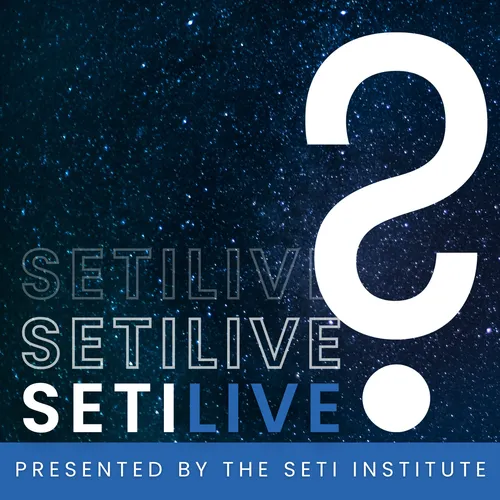
SETI Live
SETI Live is a weekly production of the SETI Institute and is recorded live on stream with viewers on YouTube, Facebook, LinkedIn, X (formerly known as Twitter), and Twitch. Guests include astronomers, planetary scientists, cosmologists, and more, working on current scientific research. Founded in 1984, the SETI Institute is a non-profit, multi-disciplinary research and education organization whose mission is to lead humanity’s quest to understand the origins and prevalence of life and intelligence in the Universe and to share that knowledge with the world.
- Update frequency
- every 7 days
- Average duration
- 34 minutes
- Episodes
- 109
- Years Active
- 2023 - 2025

Earth Detecting Earth: How Far Away Can We Detect Earth's Technosignatures?
If an extraterrestrial civilization existed with technology similar to ours, would they be able to detect Earth and evidence of humanity? If so, what signals would they detect, and from how far away?…

Unistellar + SETI: Citizen Science Q&A (Part 5)
Join Dr. Franck Marchis, Chief Science Officer and co-founder at Unistellar and director of Citizen Science at SETI Institute, and Dr. Lauren Sgro, Outreach Manager at the SETI Institute, for a conve…

Planets Form Where?? ALMA Observations Show Planet Formation in Harsh Environments
New research using the Atacama Large Millimeter/submillimeter Array (ALMA) telescope reveals that planet formation can occur in harsh, high-radiation stellar environments. This contradicts earlier as…

What to Expect in 2025 in Space Science
Happy New Year! 2024 brought us a lot of exciting space news, from a total solar eclipse to the launch of Europa Clipper and our celebration of 40 years as the SETI Institute. What does 2025 hold? Jo…

Mixed Signals: Alien Communication Across the Iron Curtain
Join communications specialist Beth Johnson and historian Rebecca Charbonneau as they discuss Dr. Charbonneau's new book, Mixed Signals. The book examines the Cold War relationship between the US and…

Uranus Breaks (Solar) Wind: Re-Analyzing Data from the Voyager 2 Mission
Get ready to giggle and make bad jokes. Uranus is back in the news. In 1986, Voyager 2 flew by the distant ice giant and made a strange discovery—the planet's magnetic field was weird. It's not just …

Asteroid Deflection via Nuclear Blasts and Sandia National Labs
Imagine that scene from every apocalyptic asteroid movie—you know the one. The scientist comes rushing in because a "new" asteroid has been detected and is on a collision course with Earth. What happ…

Unistellar + SETI: Citizen Science Q&A (Part 4)
Join Dr. Franck Marchis, Chief Science Officer and co-founder at Unistellar and director of Citizen Science at SETI Institute, and Dr. Lauren Sgro, Outreach Manager at the SETI Institute, for a conve…

SETI Institute 40th Anniversary Panel: Looking Back to Look Ahead
Nearly 40 years ago, on November 20, 1984, the SETI Institute was incorporated with inaugural officers CEO Thomas Pierson and SETI scientist Jill Tarter. The goal was to provide SETI researchers with…

How to Kill an Asteroid with Dr. Robin George Andrews
OSIRIS-REx and the Hayabusa spacecraft have sample asteroids to understand what they're made of. NASA sent the DART mission to change the orbit of a tiny asteroid orbiting another asteroid. ESA sent …

The Hera Mission: Following Up on the DART Impact of Dimorphos
In September 2022, a small spacecraft called DART hit the surface of a tiny asteroid moonlet called Dimorphos. That spacecraft was the first test of a planetary defense system, attempting to change a…

Into the Unknown with Kelsey Johnson, Ph.D.
The cosmos is full of huge questions: "What caused the Big Bang? What happens inside black holes? Are there other dimensions?" Scientists have been working to answer these questions, but sometimes, w…

Looking for Life in All the Wrong Places: The Atacama, NASA Viking Experiments, and Salts
In 1976, NASA's two Viking spacecraft touched down on Mars, becoming the first successful landers on the red planet. On board Viking 1, the craft carried several biological experiments to search for …

The Non Random Arts Collective: Exploring Habitability, Space Exploration, and Gene Editing
Suppose global warming raised temperatures so drastically that crops failed and caused world hunger. Would you support the idea of gene editing humans’ skin cells so that photosynthesis would become …

Naked Eye Comets? October May Yield a Bounty
Comets are small objects in our solar system made of ice and dust. As they get closer to the Sun in their orbits, the ices turn into gas and give off a glow that can be seen in telescopes. With luck,…

New Exoplanets Just Dropped! And Citizen Scientists Helped Find Them
Exoplanets are planets that orbit stars outside our solar system. We've been finding potential exoplanets more often since the Kepler and TESS spacecraft were launched. But confirming these planets t…

Europa Clipper is Go! Mission Passes Milestone Toward October Launch
In the quest to find life beyond Earth, icy worlds within our solar system are full of potential. Europa, one of Jupiter's four largest (Galilean) moons, is one possible target because of the vast oc…

Finally! An Intermediate-Mass Black Hole
There are supermassive black holes. There are stellar mass black holes. And based on the idea that galaxies evolve as they merge, there should be black holes in between -- intermediate mass black hol…

Hot, Young Supernova Remnant! JWST Observations of Cas A Challenge Scientists
When a star at its life's end explodes, a debris cloud expands away from the now-dead star. The debris forms intricate and amazing structures in the expanding cloud and can cause the formation of a v…

Pollution on Exoplanets? Using Greenhouse Gases as Signs of Civilization
Scientists now can work out what the atmospheres of worlds outside our solar system are made of. Using the James Webb Space Telescope, we have seen water, carbon dioxide, methane, and other gases. Co…